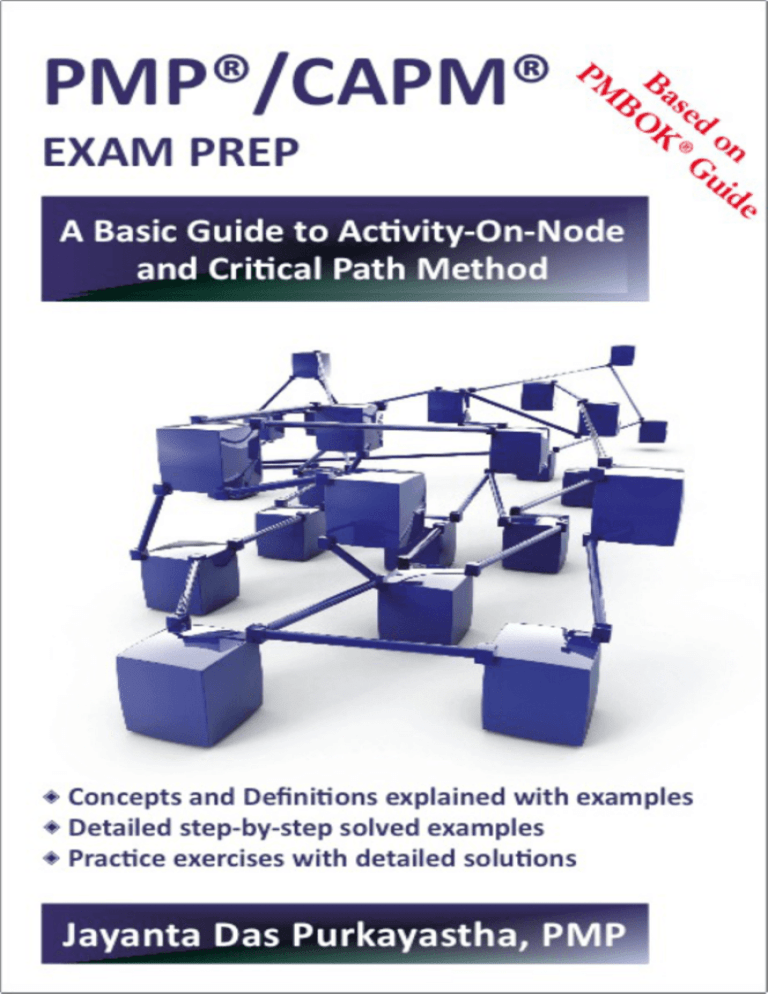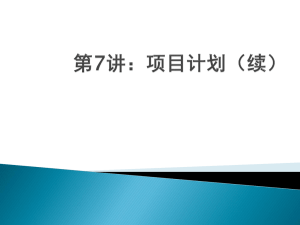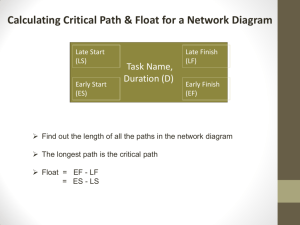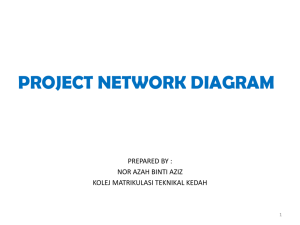
A thorough and in-depth preparation guide for PMP® and CAPM® exams
covering Precedence Diagramming Method/Activity-On-Node concepts and
their analysis using Critical Path Method. This guide explains the concepts with
illustrated examples with emphasis on special situations. Explanation of
concepts through stepwise solved examples will provide readers hands-on ability
for their application. This guide will serve as a launch pad for advanced study in
this area beyond the requirements of the two exams.
PMP®/CAPM® EXAM PREP
Order the complete book from the publisher
Booklocker.com
http://www.booklocker.com/p/books/5866.html?s=pdf
or from your favorite neighborhood
or online bookstore.
Your Free excerpt appears below. Enjoy!
PMP®/CAPM® EXAM PREP: A Basic
Guide to Activity-On-Node and
Critical Path Method
Copyright © 2011 Jayanta Das Purkayastha
ISBN 978-1-61434-504-6
All rights reserved. No part of this publication may be reproduced, stored in a
retrieval system, or transmitted in any form or by any means, electronic,
mechanical, recording or otherwise, without the prior written permission of the
author.
Although the author has made every effort to ensure accuracy and
completeness of information entered in this guide, no responsibility is assumed
for errors, inaccuracies, omissions, or inconsistencies included herein. Any
slights of people, places or organizations are completely unintentional.
PMI®, the PMBOK®, PMP®, and CAPM® are trademarks or registered trademarks
of the Project Management Institute, Inc. in the United States and other
countries. Project Management Institute, Inc. was not involved in the
production of, and does not endorse, this publication.
Front Image © Sashkinw | Dreamstime.com
Dedication Photo © 2011 Jayanta Das Purkayastha
ATTENTION CORPORATIONS, UNIVERSITIES, COLLEGES, AND PROFESSIONAL
ORGANIZATIONS. Quantity discounts are available on bulk purchases of this
guide. For information, please contact the publisher.
Published in the United States by Booklocker.com, Inc., Bangor, Maine.
Printed in the United States of America on acid-free paper.
Booklocker.com, Inc.
2011
First Edition
Table of Contents
What This Guide Is About
xiii
What this Guide Is Not About
xiii
Who This Guide Is For
xiv
Feedback
xiv
Section 1: Get the Basics
1
Summary ...................................................................................................................... 3
Introduction ................................................................................................................. 3
Understanding Basics of an Activity: Building Block of Activity-On-Node
(AON) ........................................................................................................................ 6
Understanding Basics of Precedence Diagramming Method (PDM)/
Activity-On-Node (AON) Diagram .................................................................... 15
Section 2: Critical Path Method
23
Understanding Critical Activities and Critical Path............................................. 25
Determine Critical Path in a Project Network Diagram ..................................... 26
Section 3: Critical Path Analysis of AON using CPM
31
Determining Activity Early Start and Early Finish: Forward Pass ........................ 33
Determining Activity Late Start and Late Finish: Backward Pass ...................... 37
Section 4: Solved Examples
43
Example 1................................................................................................................... 45
Example 2................................................................................................................... 48
Example 3................................................................................................................... 52
Example 4................................................................................................................... 56
Example 5................................................................................................................... 61
Section 5: Conclusion
67
Benefits of Using AON and CPM ............................................................................ 69
Practice Exercises
71
Further Readings
74
ix
Solutions
Index
x
75
101
Table of Figures
FIGURE 1 Interdependencies between Create WBS, Define Activities, and
Sequence Activities ....................................................................................................... 5
FIGURE 2 WBS Work Packages, Activities and Tasks ................................................. 7
FIGURE 3 Schedule-related attributes of an activity ................................................ 9
FIGURE 4 Predecessor and successor activities ...................................................... 16
FIGURE 5 Finish-Start (FS) Sequence: Activity A must finish before Activity B can
start ................................................................................................................................. 17
FIGURE 6 Finish-Finish (FF) Sequence: Activity A must finish before Activity B can
finish. ............................................................................................................................... 18
FIGURE 7 Start-Finish (SF) Sequence: Activity A must start before Activity B can
finish ................................................................................................................................ 19
FIGURE 8 Start-Start (SS) Sequence: Activity A must start before Activity B can
start. ................................................................................................................................ 19
FIGURE 9 An Activity-On-Node network diagram with two paths ....................... 20
FIGURE 10 Using activity duration to determine Critical Path(s) in AON ............ 26
FIGURE 11 Using activity float to determine Critical Path(s) in AON .................... 28
xi
Section 5: Conclusion
“I am not sure about project scope but we have
microscopes and telescopes.”
Jayanta Das Purkayastha
Understanding AONs and how CPM can be used to analyze them,
covers an important aspect of time management for projects. While there
exists software that can be used to create AONs and perform CPM, as a
project management professional it is important to know the basic concepts,
techniques and how they are applied in order to comprehend and interpret
results. Such understanding becomes even more critical when one seeks to
create and analyze what-if scenarios. Determining the appropriate and
efficient organization of activities including minimizing critical activities and
ensuring no-occurrence of negative float or negative total float is an
important part of schedule management.
It must also be understood that network diagrams are never static. They
can change as project conditions, constraints and other factors change.
Project network diagrams can evolve in cases where Rolling Wave Planning is
used especially when all project requirements or details are available during
the planning phase. Below are benefits that AON and CPM provide for project
managers in order to actively, effectively and efficiently manage project
schedules.
Knowledge and understanding of the advantages that Activity-OnNode network diagrams bring, along with the use of critical path analysis, is
significant in ensuring that they are actually used in management of projects.
Benefits of Using AON and CPM
1. AON provides graphical representation of activity sequence and
dependency making it convenient to plan and manage schedule
activities. Visual representation makes it easier to communicate the
project’s activities, their sequence and time attributes.
2. The minimum amount of time required to complete the project can be
easily and objectively determined from the network diagram given that
the duration of each activity is provided or estimated.
3. Critical Path analysis of a network diagram allows for the identification of
critical, near-critical and non-critical activities in the project. Especially
for critical activities, it will be easier to determine if there is (are) any
threat(s) to the project’s completion date.
4. Impact assessments on project schedule can be made for different whatif scenarios. For example, different scenarios can be evaluated to see if
SECTION 5: CONCLUSION
69
PMP®/CAPM® Exam Prep
A Basic Guide to Activity-On-Node and Critical Path Method
a planned project schedule can be compressed to meet a customer
imposed completion date which is earlier than the planned completion
date.
5. AONs can be very helpful in tracking project performance with regards
to schedule. For instance, delay to an identified critical activity can be
immediately identified, and steps can be taken to reduce any threat to
the project’s completion date.
6. For each activity, the early (start or finish) and late (start or finish) dates
can be determined allowing for better schedule management at
individual activity level.
7. AONs accommodate all types of logical relationships between
activities—FS, FF, SS, SF—including Lags and Leads unlike AOAs which
can only use FS (Taylor, 2007).
It is not surprising that no tools and techniques are without disadvantage(s)
and limitation(s). One of the frequently cited disadvantages of AONs is the
sheer difficulty of constructing it for large complex projects with very large
number of activities and dependencies. Hard copy representation of such
large network diagrams can be very unwieldy. In addition, use of critical path
method on large network diagrams can be cumbersome. Use of software
programs that handle creation of network diagrams and critical path analysis
can greatly assist in mitigating this disadvantage. The limitation of CPM, which
one must have noticed already, is that it relies on the duration of each activity
in the network diagram. So, it assumes that the duration of each activity can
be relied upon. Therefore, the efficacy of CPM depends heavily on this
assumption.
70
SECTION 5: CONCLUSION
Jayanta Das Purkayastha
Practice Exercises
1. For the network diagram below, determine the following:
(a) Critical Path
(b) ES, EF, LS, LF and Float for each activity
2. For the network diagram below, determine the following:
(a) Critical Path
(b) ES, EF, LS, LF and Float for each activity
ES
7
EF
ES
B
1
4
9
EF
C
LS
Slack
LF
LS
Slack
LF
ES
3
EF
ES
2
EF
LS
Slack
LF
LS
Slack
4
A
LS
Start
Slack
LF
End
D
E
LF
3.
Activity
Predecessor(s)
Duration (days)
A
B
C
D
E
F
G
H
End
Start
A, C, F
Start
Start
B, F
C
D, F
F, G
E, H
4
7
3
4
2
4
9
7
0
PRACTICE EXERCISES
71
PMP®/CAPM® Exam Prep
A Basic Guide to Activity-On-Node and Critical Path Method
Based on the activity details given above, do the following:
(a) Construct the AON.
(b) Determine Critical Path
(c) Determine ES, EF, LS, LF and Float for each activity
4. An activity in a network diagram has an Early Start (ES) of 3 days, Duration
of 6 days and Late Finish (LF) of 12 days. What is activity's float?
(a) 2 days
(b) 4 days
(c) 3 days
(d) 5 days
5. An activity in a network diagram has Duration of 5 days and Early Finish (EF)
of 11 days. What is activity's Early Start (ES)?
(a) 7 days
(b) 4 days
(c) 8 days
(d) 3 days
6. An activity in a network diagram has Duration of 5 days and Late Finish (LF)
of 11 days. What is activity's Late Start (LS)?
(a) 7 days
(b) 4 days
(c) 8 days
(d) 3 days
7. An activity in a network diagram has Duration of 5 days and Late Start (LS)
of 3 days. What is activity's Late Finish (LF)?
(a) 7 days
(b) 4 days
(c) 8 days
(d) 3 days
8. A landscaper must complete preparing the flower bed before the flower
plants can be planted. The relationship between “prepare flower bed”
activity and “plant flower plants” can be best described as:
72
PRACTICE EXERCISES
Jayanta Das Purkayastha
(a) Start-Finish (SF)
(b) Finish-Start (FS)
(c) Finish-Finish (FF)
(d) Start-Start (SS)
9. A homeowner plans to sealcoat the driveway of his house. He has already
purchased the required quantity of driveway seal coater and the weather
would be right to do it. The seal coating material dries quickly and
therefore, must be spread without delay. He has already washed and
cleaned his driveway, and is prepared to start sealcoating the driveway.
Next day, he knows he has to primarily perform two activities—pour the
seal coater, and spread the sealcoater. The relationship between the
predecessor activity to pour the sealcoater and the successor activity to
spread the seal coater can be best described as:
(a) Start-Finish (SF)
(b) Finish-Start (FS)
(c) Finish-Finish (FF)
(d) Start-Start (SS)
10. At a trade show, two teams were employed to set up electric connection
and lighting for each booth. One team laid out the electric cables and
connection while the other team set up the lighting and made sure it was
set up as per specifications. Both teams must ensure that they have fully
completed before the scheduled start date. The relationship between the
two teams activities can be best described as:
(a) Start-Finish (SF)
(b) Finish-Start (FS)
(c) Finish-Finish (FF)
(d) Start-Start (SS)
PRACTICE EXERCISES
73
Jayanta Das Purkayastha
Index
A
Activity-on-Arrow.................... 3, 15
Activity-On-Node ........... 3, 5, 6, 15
ADM ....... See Arrow Diagramming
Method
AOA ............ See Activity-on-Arrow
AON ............ See Activity-On-Node
Arrow Diagramming Method. 3, 5,
15
B
Backward Pass ... 6, 33, 37, 38, 78,
84, 86, 91
C
CPM ...... See Critical Path Method
Critical Activities ..................... 6, 25
critical activity ............................ 25
critical path.. 14, 25, 26, 33, 77, 83,
84, 89, 90, 98, 99
Critical Path .. 14, See critical path
Critical Path Method .. 3, 5, 23, 25,
33
D
Duration.. 6, 8, 9, 10, 12, 25, 30, 71,
77, 84, 89, 90
E
Early Finish ... 6, 9, 10, 11, 12, 14, 33
Early Start..... 6, 9, 10, 11, 12, 14, 33
EF ............................. See Early Finish
Effort ........................................... 8, 9
ES .............................. See Early Start
F
FF ............................ See Finish-Finish
Finish Float ..............................11, 12
Finish-Finish ...................6, 15, 17, 18
Finish-Start ....................6, 15, 16, 17
Finish-to-Finish ....... See Finish-Finish
Finish-to-Start .......... See Finish-Start
Float ........................6, 10, 25, 71, 72
Forward Pass ...6, 33, 34, 38, 78, 84,
90, 91
Free Float ...............................10, 15
FS ............................. See Finish-Start
H
Hypercritical.............................6, 25
L
Lag ............................................6, 21
Late Finish .........6, 10, 11, 12, 14, 37
Late Start 6, 9, 10, 11, 12, 14, 37, 38
Lead .........................................6, 22
LF ............................. See Late Finish
LS ...............................See Late Start
N
Near-Critical Activities ................25
Near-Critical Paths ......................25
Negative Float .............................14
Network Path ...............................25
P
PDM .................... See Precedence
Diagramming Method
SOLUTIONS
101
PMP®/CAPM® Exam Prep
A Basic Guide to Activity-On-Node and Critical Path Method
Precedence Diagramming
Method .................... 3, 6, 15, 74, 89
Project Float................................. 14
S
SF ............................. See Start-Finish
Slack ....................... 6, 10, 83, 89, 99
SS...............................See Start-Start
Start Float ............................... 11, 12
Start-Finish .................... 6, 15, 18, 19
Start-Start ........................... 6, 15, 19
Start-to-Finish ......... See Start-Finish
102
Start-to-Start............. See Start-Start
Supercritical ................................. 25
T
Total Float ........................ 12, 15, 25
W
WBS .............. See Work Breakdown
Structure
Work Breakdown Structure .......... 6
work package............................... 6
work package element ............... 6
A thorough and in-depth preparation guide for PMP® and CAPM® exams
covering Precedence Diagramming Method/Activity-On-Node concepts and
their analysis using Critical Path Method. This guide explains the concepts with
illustrated examples with emphasis on special situations. Explanation of
concepts through stepwise solved examples will provide readers hands-on ability
for their application. This guide will serve as a launch pad for advanced study in
this area beyond the requirements of the two exams.
PMP®/CAPM® EXAM PREP
Order the complete book from the publisher
Booklocker.com
http://www.booklocker.com/p/books/5866.html?s=pdf
or from your favorite neighborhood
or online bookstore.








